Optimal of Placement for Battery Energy Storage System Installation Using Fuzzy Expert System in Thailand: A Case Study of Critical Closed-Circuit Television Positions
Abstract
1. Introduction
2. Methodology
2.1. Data Collection and Raw Data Transformation
2.2. Genetic Algorithm
2.3. Neural Network
2.4. Fuzzy Logic System
2.5. Comparison of Algorithms
2.6. Fuzzy Logic System Design
2.6.1. Input Variables
2.6.2. Output Variable
2.6.3. Rules of Fuzzy Logic
2.6.4. Processing in a Fuzzy Logic System
- Fuzzification:
- Rule Evaluation:
- Aggregation:
- Defuzzification
2.6.5. Grouping of Evaluation Results
3. Results
3.1. Latkrabang Subdistrict
3.2. Thapyao Subdistrict
3.3. Lamphla Tiew Subdistrict
3.4. Khumthong Subdistrict
3.5. Khlongsam Prawet Subdistrict
3.6. Khlongsong Ton Nun Subdistrict
4. Conclusions
Author Contributions
Funding
Data Availability Statement
Conflicts of Interest
References
- Bhatti, M.T.; Khan, M.G.; Aslam, M.; Fiaz, M.J. Weapon Detection in Real-Time CCTV Videos Using Deep Learning. IEEE Access 2021, 9, 34366–34382. [Google Scholar] [CrossRef]
- Singh, V.; Singh, S.; Gupta, P. Real-Time Anomaly Recognition Through CCTV Using Neural Networks. Procedia Comput. Sci. 2020, 173, 254–263. [Google Scholar] [CrossRef]
- Yin, X.; Ma, T.; Bouferguene, A.; Al-Hussein, M. Automation for sewer pipe assessment: CCTV video interpretation algorithm and sewer pipe video assessment (SPVA) system. Autom. Constr. 2021, 125, 103622. [Google Scholar] [CrossRef]
- Wang, M.; Kumar, S.S.; Cheng, J.C. Automated sewer pipe defect tracking in CCTV videos based on defectdetection and metric learning. Autom. Constr. 2021, 121, 103438. [Google Scholar] [CrossRef]
- Choi, W.; Sung, H.; Chong, K. AI-Driven Particulate Matter Estimation Using Urban CCTV: A Comparative Analysis Under Various Experimental Conditions. Appl. Sci. 2024, 14, 9629. [Google Scholar] [CrossRef]
- Maksymowicz, K.; Kuzan, A.; Szleszkowski, L.; Tunikowski, W. Anthropological Comparative Analysis of CCTV Footage in a 3D Virtual Environment. Appl. Sci. 2023, 13, 11879. [Google Scholar] [CrossRef]
- Lim, S.; Kwon, S.H.; Shin, G.; Lee, S. Deep Learning for Automated Water Segmentation through CCTV Images in Agricultural Reservoirs. Eng. Proc. 2024, 69, 140. [Google Scholar] [CrossRef]
- Choi, W.; Jang, B.; Jung, I.; Sung, H.; Jang, Y. Evaluation of Preferences for a Thermal-Camera- Based Abnormal Situation Detection Service via the Integrated Fuzzy AHP/TOPSIS Model. Appl. Sci. 2023, 13, 11591. [Google Scholar] [CrossRef]
- Seong, N.; Kim, J.; Lim, S. Graph-Based Anomaly Detection of Ship Movements Using CCTV Videos. J. Mar. Sci. Eng. 2023, 11, 1956. [Google Scholar] [CrossRef]
- Song, J.; Nang, J. Pedestrian Abnormal Behavior Detection System Using Edge–Server Architecture for Large–Scale CCTV Environments. Appl. Sci. 2024, 14, 4615. [Google Scholar] [CrossRef]
- Ahn, Y.; Choi, H.; Kim, B.S. Development of early fire detection model for buildings using computer vision-based CCTV. J. Build. Eng. 2023, 65, 105647. [Google Scholar] [CrossRef]
- Wang, G.; Ding, H.; Duan, M.; Pu, Y.; Yang, Z.; Li, H. Fighting against terrorism: Areal-time CCTV autonomous weapons detection based on improved YOLO v4. Digit. Signal Process. 2023, 132, 103790. [Google Scholar] [CrossRef]
- González, J.L.; Zaccaro, C.; Álvarez-García, J.A.; Morillo, L.M.; Caparrini, F.S. Real-time gun detection in CCTV: An open problem. Neural Netw. 2020, 132, 297–308. [Google Scholar]
- Elaadouli, N.; Lajouad, R.; El Magri, A.; Mansouri, A.; Elmezdi, K. Adaptive control strategy for energy management in a grid-connected Battery Energy Storage System using a bidirectional Vienna rectifier. J. Energy Storage 2024, 104, 114382. [Google Scholar] [CrossRef]
- Okafor, C.E.; Folly, K.A. Design and implementation of a control system for multifunctional applications of a Battery Energy Storage System (BESS) in a power system network. Clener Energy Syst. 2024, 9, 100153. [Google Scholar] [CrossRef]
- Chauhan, R.; Santran, R.; Obrecht, M.; Singh, R. Energy storage potential of used electric vehicle batteries for supporting renewable energy generation in India. Energy Sustain. Dev. 2024, 81, 101513. [Google Scholar] [CrossRef]
- Serat, Z. Optimizing renewable energy systems for 100% clean energy target: A comparative study of solar, hydro, pumped hydro, and battery storage technologies. J. Energy Storage 2024, 104, 114441. [Google Scholar] [CrossRef]
- Saleem, M.I.; Saha, S.; Izhar, U.; Ang, L. A stochastic MPC-based energy management system for integrating solar PV, battery storage, and EV charging in residential complexes. Energy Build. 2024, 325, 114993. [Google Scholar] [CrossRef]
- Vega-Garita, V.; Alpizar–Gutierrez, V.; Calderon-Obaldia, F.; Núñez–Mata, O.; Arguello, A.; Immonen, E. Iterative sizing methodology for photovoltaic plants coupled with battery energy storage systems to ensure smooth power output and power availability. Energy Convers. Manag. X 2024, 24, 100716. [Google Scholar] [CrossRef]
- Jiménez-Ruiz, J.; Honrubia-Escribano, A.; Gómez-Lázaro, E. Combined Use of Python and DIgSILENT PowerFactory to Analyse Power Systems with Large Amounts of Variable Renewable Generation. Electronics 2024, 13, 2134. [Google Scholar] [CrossRef]
- Dyussembekova, N.; Schütt, R.; Leiße, I.; Ralfs, B. Decision Process for Identifying Appropriate Devices for Power Transfer between Voltage Levels in Distribution Grids. Energies 2024, 17, 2158. [Google Scholar] [CrossRef]
- Ishraque, M.F.; Rahman, A.; Shezan, S.A.; Shafiullah, G.M.; Alenezi, A.H.; Hossen, M.D.; Bintu, N.E.N. Design Optimization of a Grid-Tied Hybrid System for a Department at a University with a Dispatch Strategy-Based Assessment. Sustainability 2024, 16, 2642. [Google Scholar] [CrossRef]
- Garibello-Narváez, D.R.; Gómez-Luna, E.; Vasquez, J.C. Performance Evaluation of Distance Relay Operation in Distribution Systems with Integrated Distributed Energy Resources. Energies 2024, 17, 4735. [Google Scholar] [CrossRef]
- Traffic and Transportation Department, Bangkok Metropolitan Administration, CCTV Image Report. 2023.
- Metropolitan Electricity Authority, Formal Outage Feeder Report. 2023.
- Kumar, A.; Kashyap, H.; Malhotra, H.; Rawat, K.; Kumar, G.; Soni, U. Preferential Selection of Locations for Installing CCTV using Fuzzy TOPSIS approach: A case study for North Delhi. In Proceedings of the 2019 Twelfth International Conference on Contemporary Computing (IC3), Noida, India, 8–10 August 2019. [Google Scholar]
- Medvediev, I.; Muzylyov, D.; Montewka, J. A model for agribusiness supply chain risk management using fuzzy logic. Case study: Grain route from Ukraine to Poland. Transp. Res. 2024, 190, 103691. [Google Scholar] [CrossRef]
- Rathour, L.; Singh, V.; Sharma, M.K.; Dhiman, N.; Mishra, V.N. A review of fuzzy logic analysis in COVID-19 pandemic and a new technique through extended hexagonal intuitionistic fuzzy number in analysis of COVID-19. Results Control. Optim. 2024, 17, 100498. [Google Scholar] [CrossRef]
- Hassan, M.N.; Fariha, F.T.; Zayee, Z.; Hasan, M. Analyzing different functional and dyeing performance of natural blended fabric utilizing natural dyes and quality prediction by fuzzy logic. Heliyon 2024, 10, e40399. [Google Scholar] [CrossRef]
- Usman, H.M.; ElShatshat, R.; El-Hag, A.H. Energy management for smart residential homes: A real-time fuzzy logic approach. Electr. Power Syst. Res. 2025, 238, 111057. [Google Scholar] [CrossRef]
- Dey, A.; Ashok, S.D. Fuzzy logic based qualitative indicators for promoting extended producer responsibility and sustainable food packaging waste management. Environ. Sustain. Indic. 2024, 24, 100534. [Google Scholar] [CrossRef]
- Mavani, N.R.; Ismail, M.A.; Abd Rahman, N.; Ali, J.M. Fuzzy logic-based barcode scanning system for food products halal identification. Food Control 2025, 168, 110926. [Google Scholar] [CrossRef]
- Arun, M.; Efremov, C.; Barik, D.; Sharma, P.; Bora, B.J.; Kowalski, J.; Le, H.C.; Truong, T.H.; Cao, D.N. Fuzzy logic-supported building design for low-energy consumption in urban environments. Case Stud. Therm. Eng. 2024, 64, 105384. [Google Scholar] [CrossRef]
- Khalil, E.; Akter, M. Prediction of seam strength of cotton canvas fabric using fuzzy logic. Results Control. Optim. 2024, 17, 100502. [Google Scholar] [CrossRef]
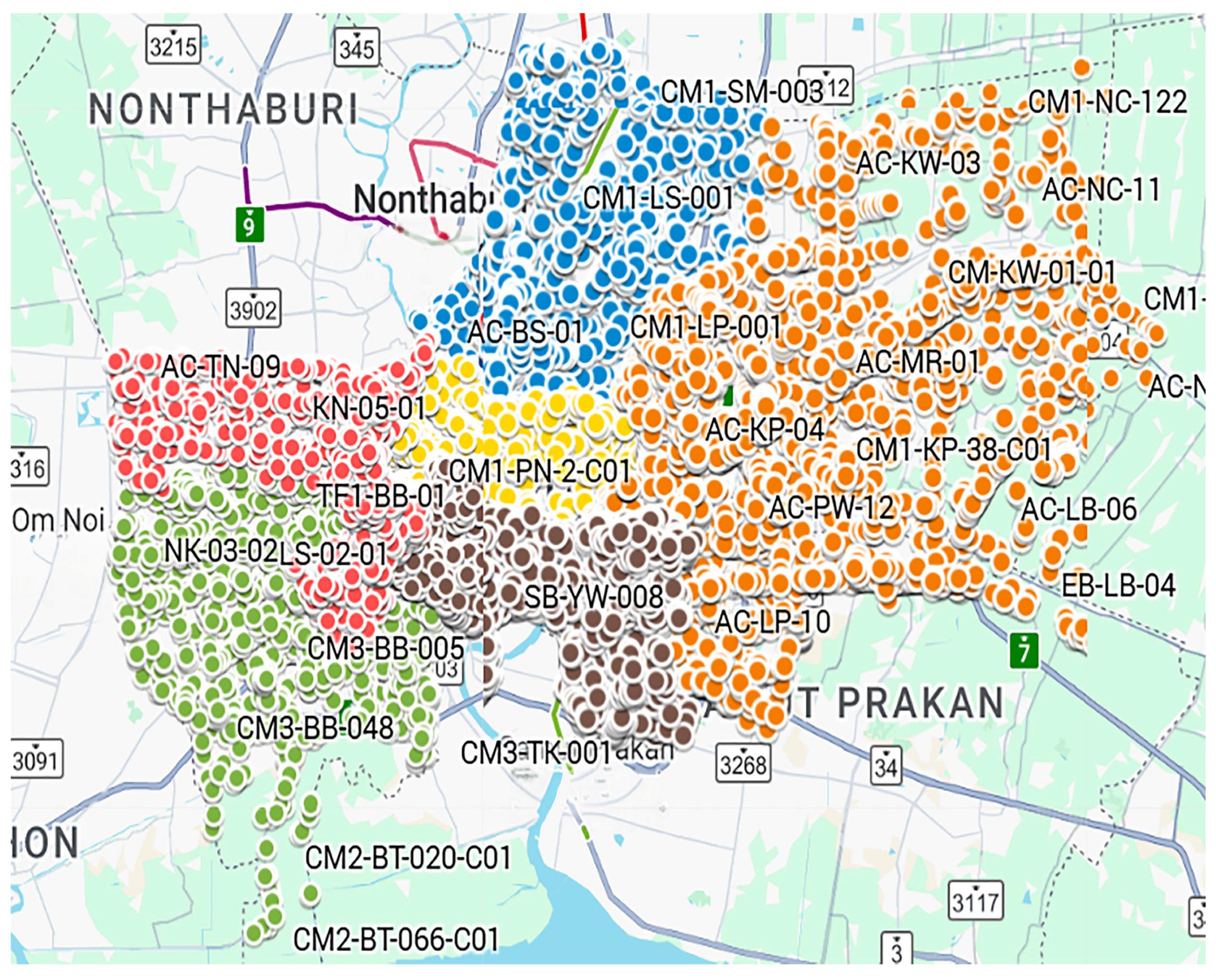
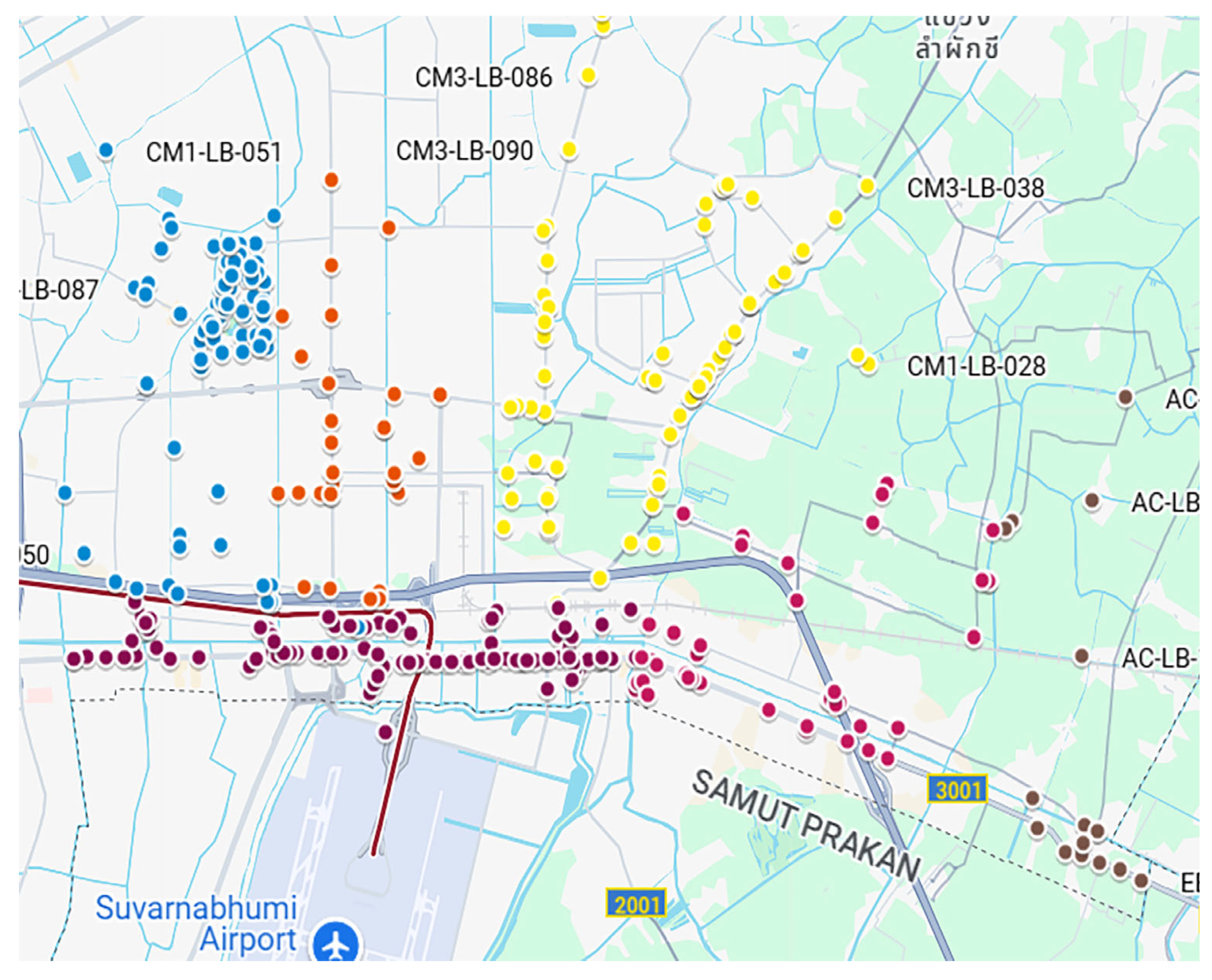

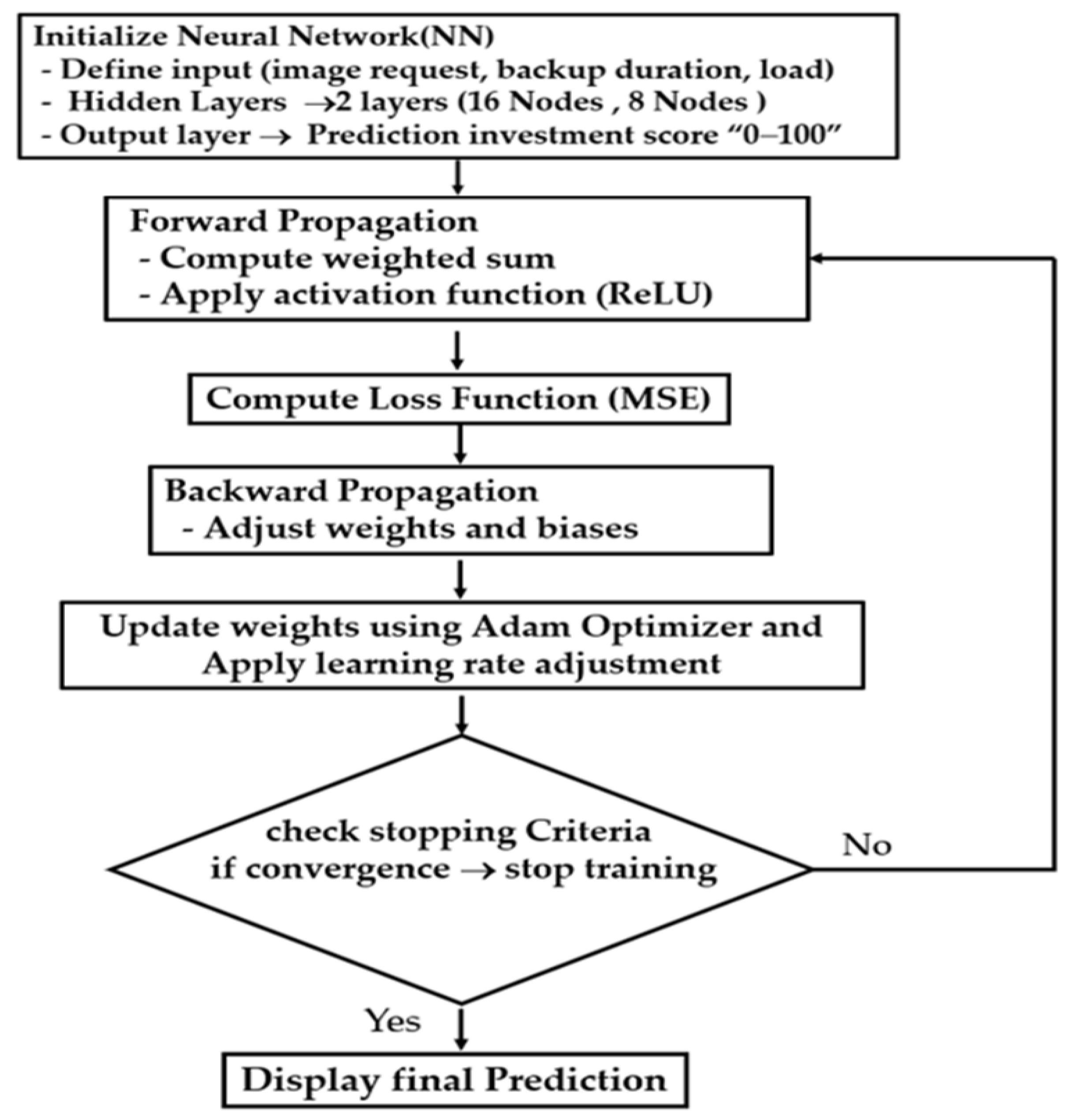
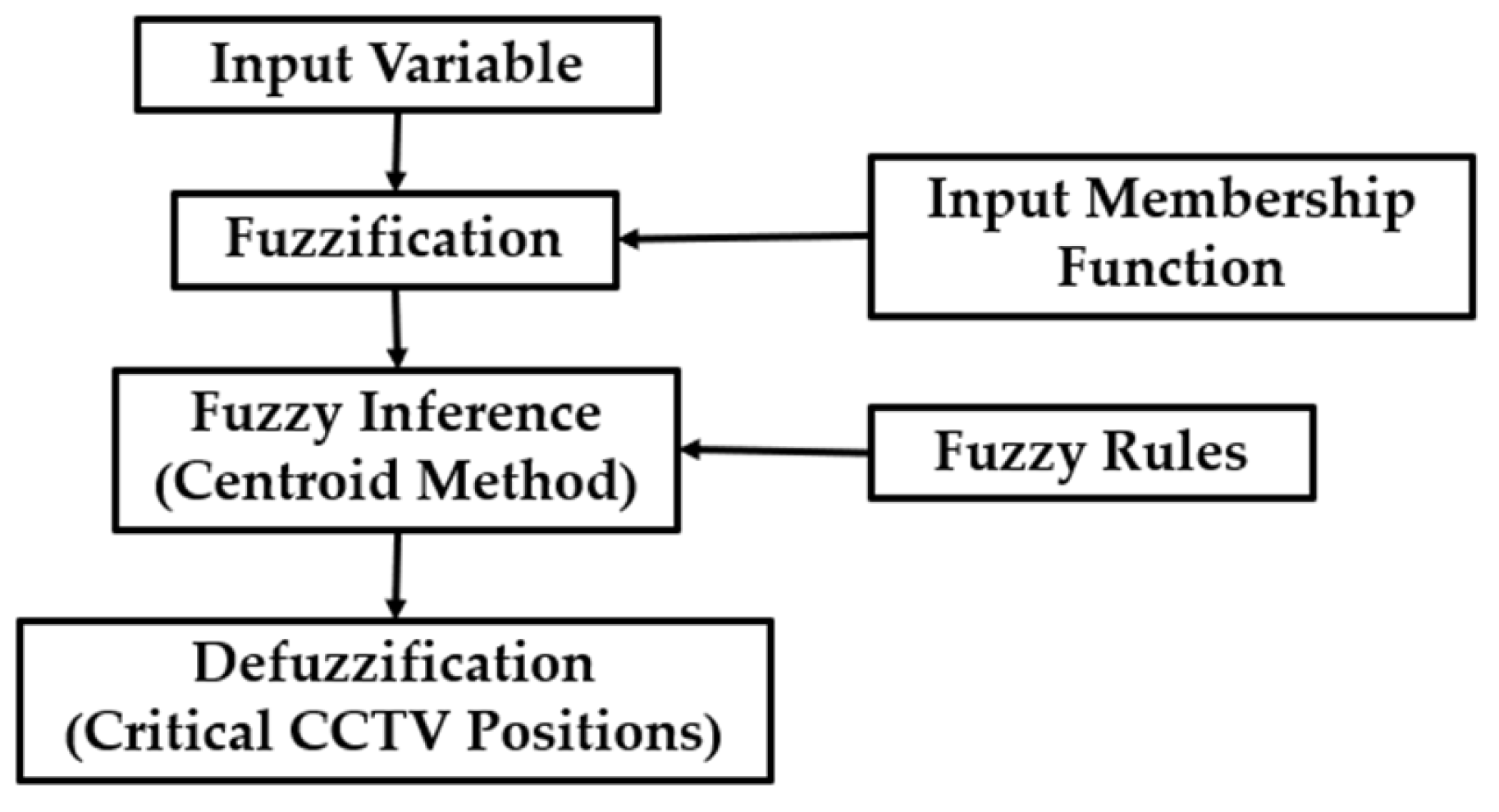
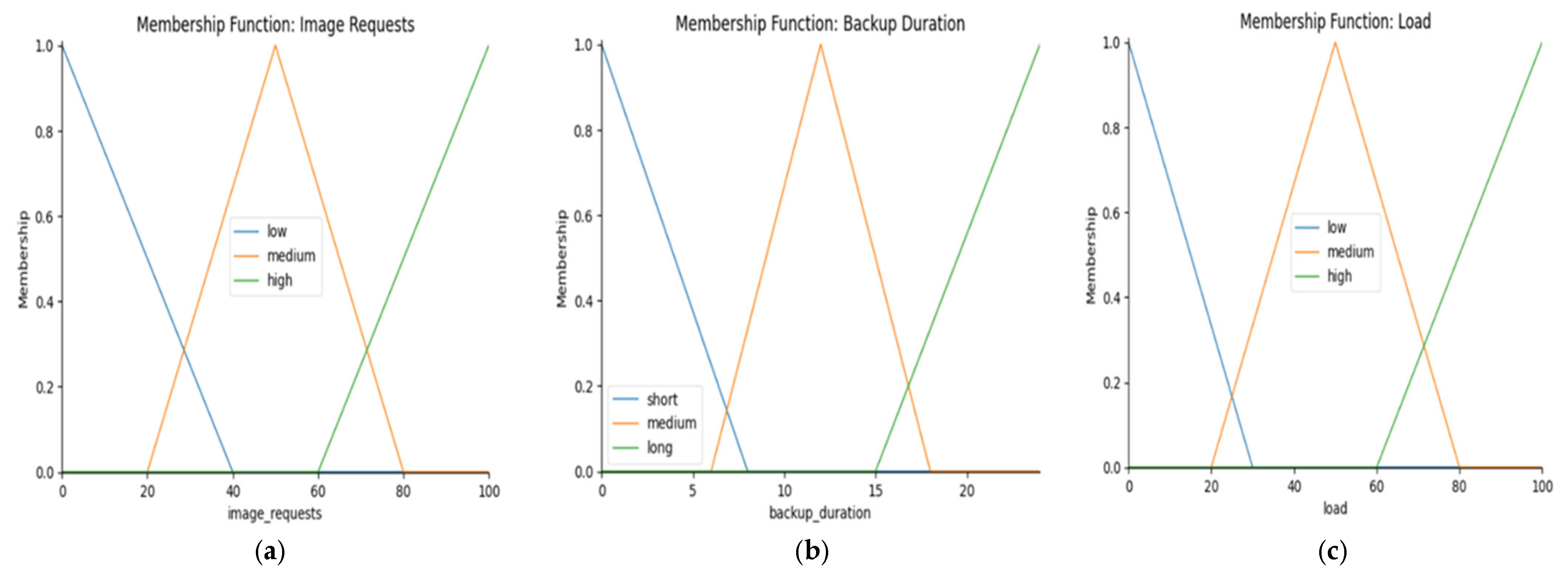
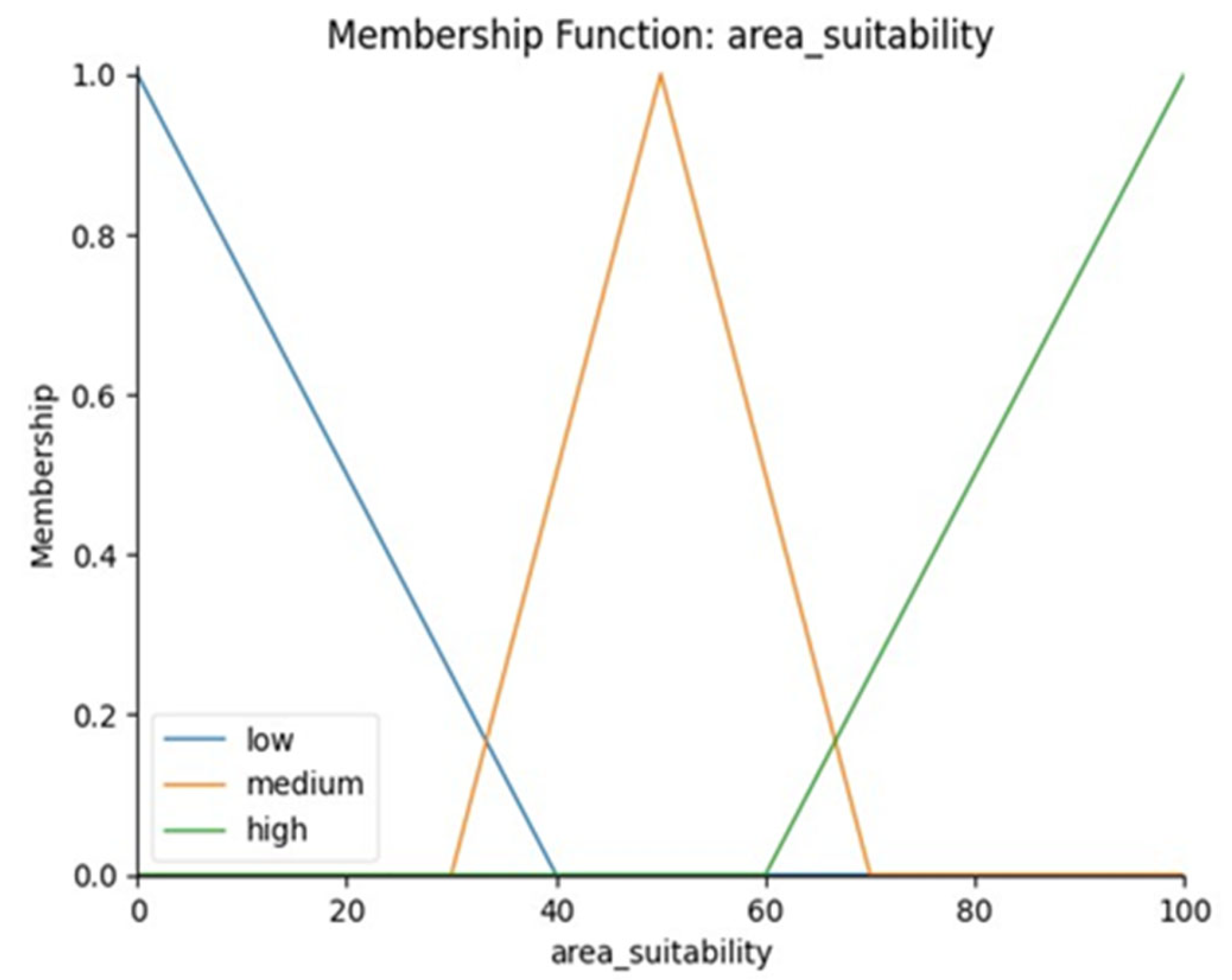
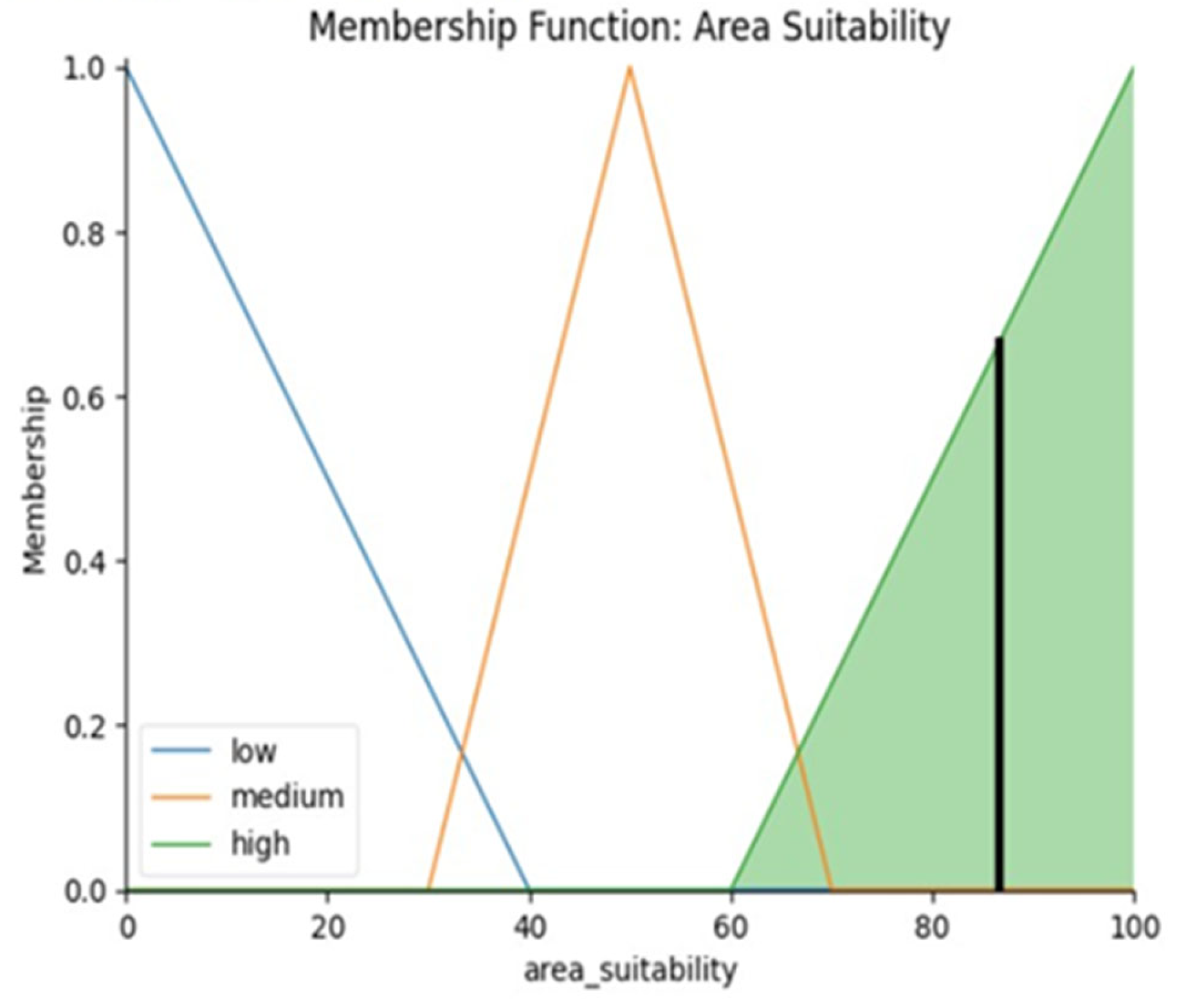

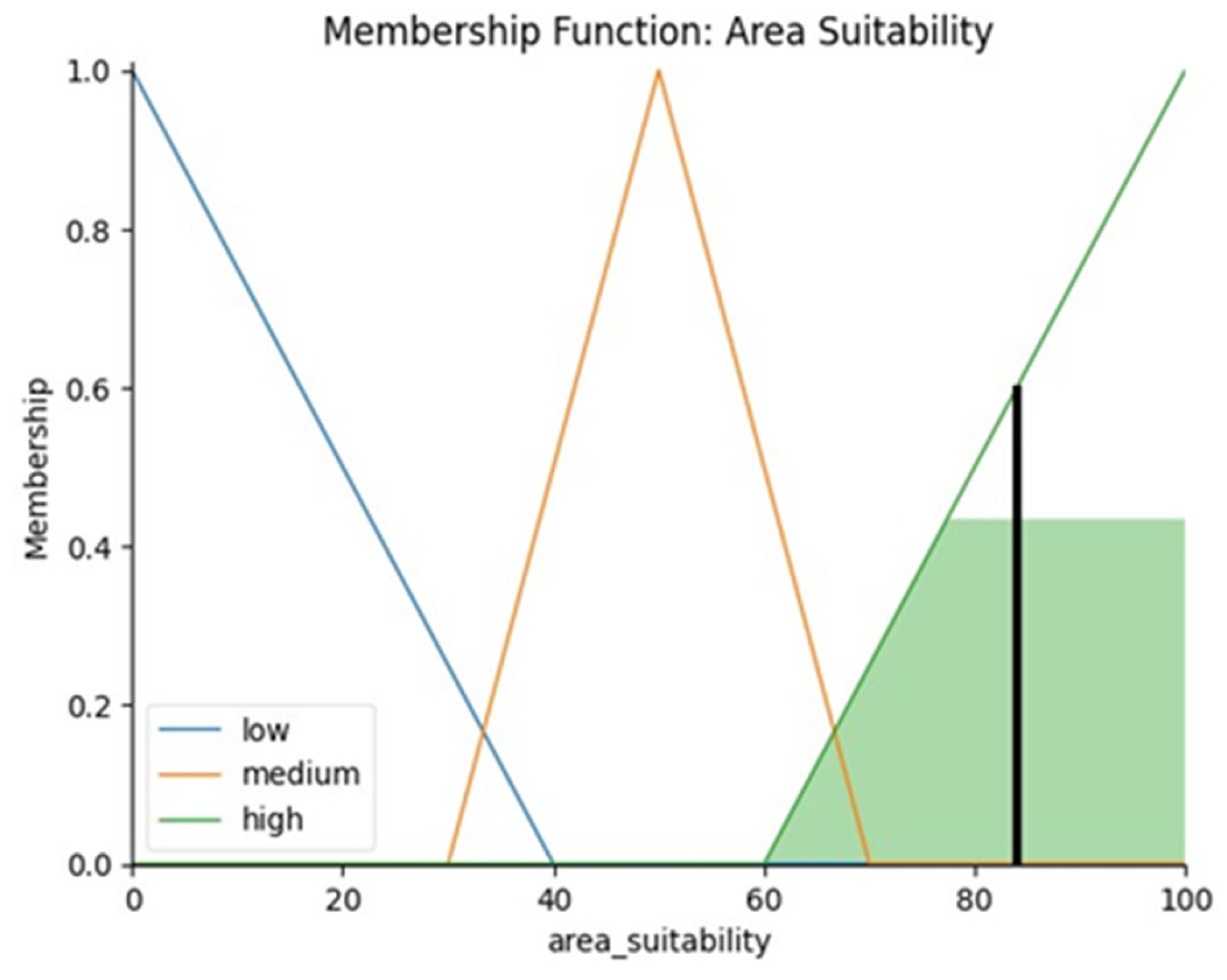
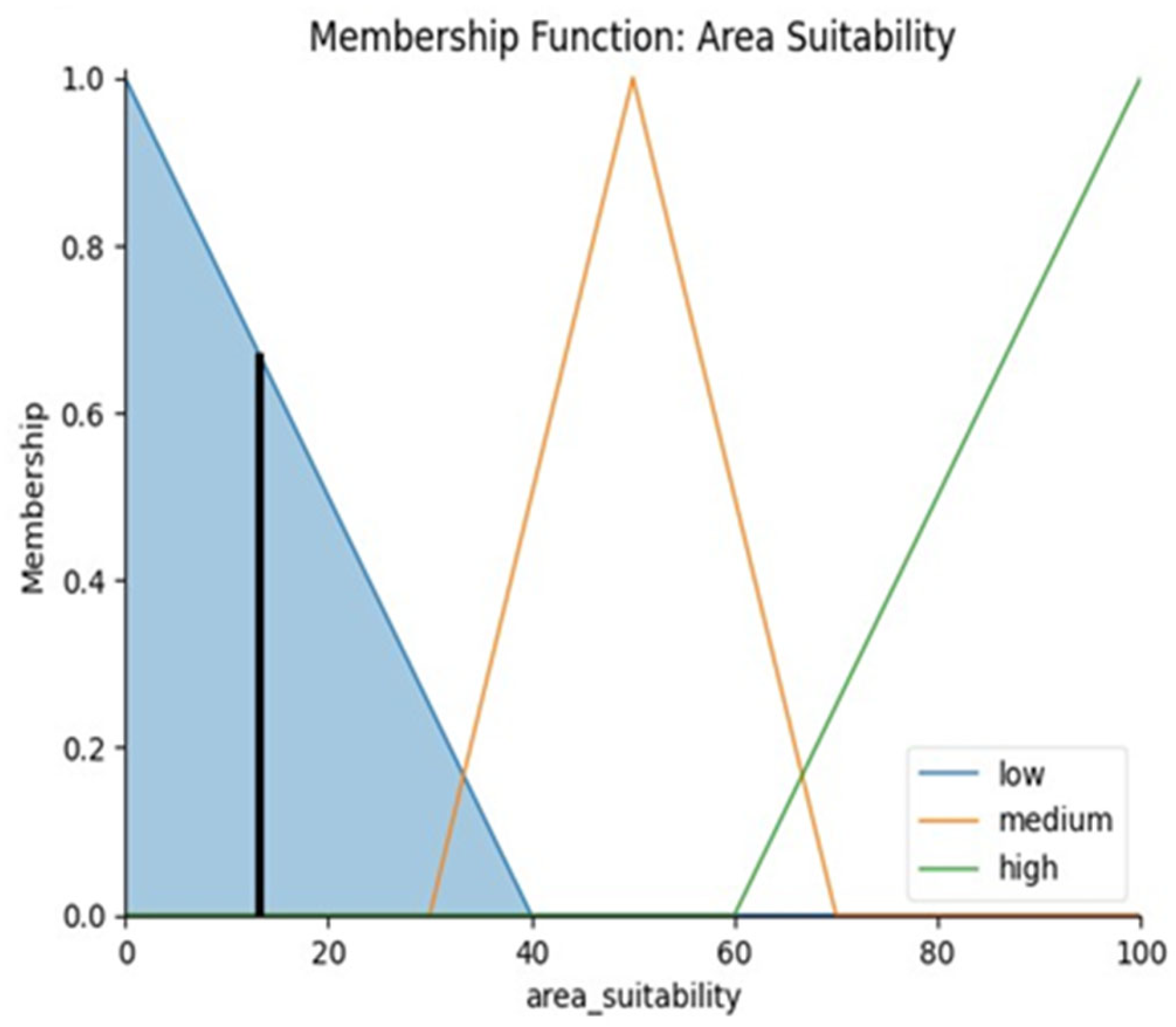
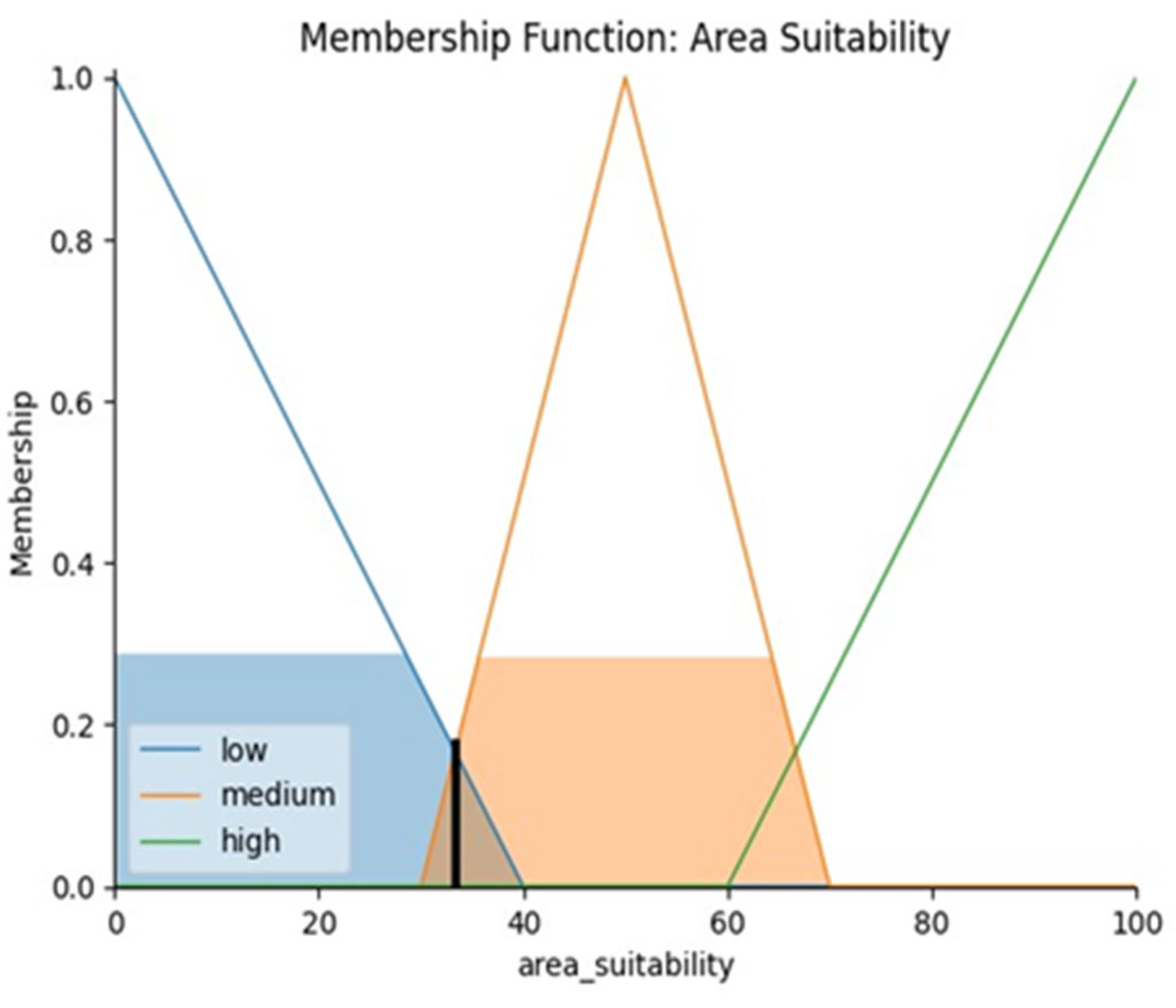
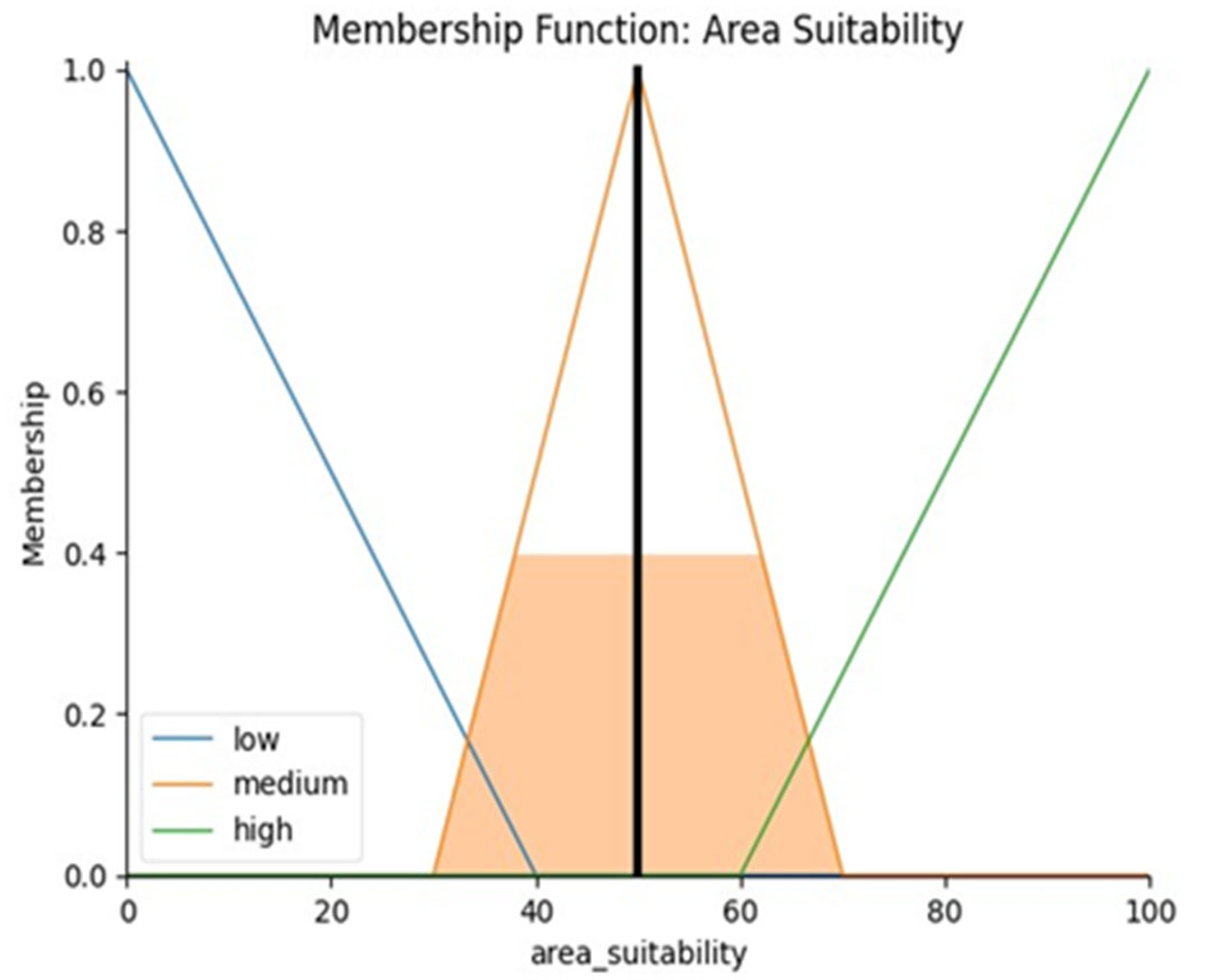
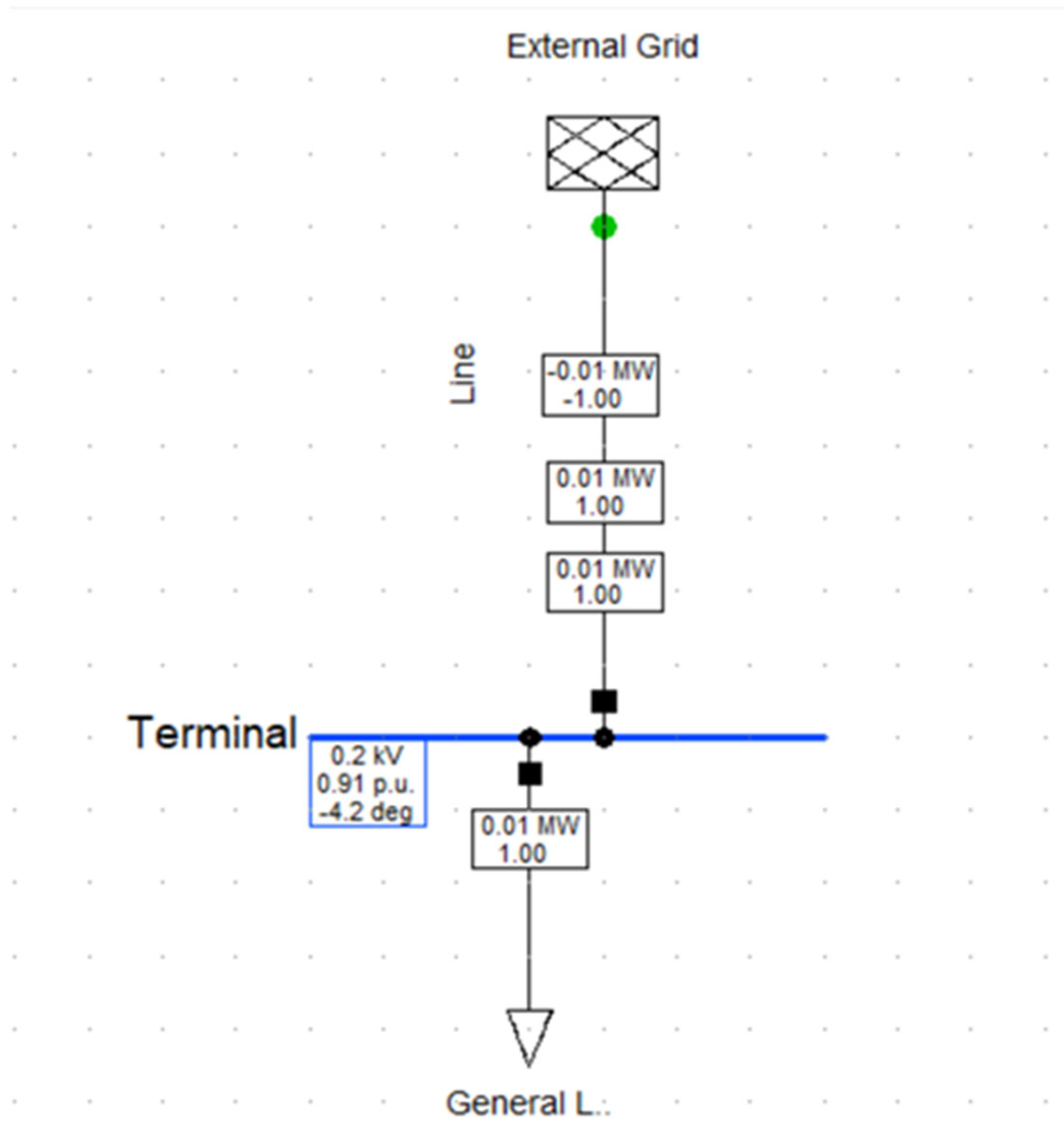
| Subdistrict | Number of CCTV Cameras |
|---|---|
| Latkrabang | 101 |
| Thapyao | 45 |
| Lamphla Tiew | 82 |
| Khamthong | 17 |
| Khlongsam Pravet | 30 |
| Khlongsong Ton Nun | 93 |
| Parameter | Explanation | ||
|---|---|---|---|
| Image Requests | 0 | 100 | The number of requests for CCTV footage ranges from 0 (no requests) to 100 (maximum). |
| Backup Duration | 0 | 100 | The cumulative duration of power outages ranges from 0 to 100 h. |
| Load | 0 | 100 | The load capacity of the CCTV cameras is set to not exceed 100%. |
| Subdistrict | Number of Requests | Normalized Data |
|---|---|---|
| Latkrabang | 214 | 100 |
| Thapyao | 96 | 41 |
| Lamphla Tiew | 104 | 45 |
| Khamthong | 14 | 0 |
| Khlongsam Pravet | 71 | 28.50 |
| Khlongsong Ton Nun | 131 | 58.50 |
| Subdistrict | Duration (min.) | Normalized Data |
|---|---|---|
| Latkrabang | 456 | 100 |
| Thapyao | 11 | 2.41 |
| Lamphla Tiew | 450 | 98.68 |
| Khamthong | 0 | 0 |
| Khlongsam Pravet | 352 | 77.19 |
| Khlongsong Ton Nun | 22 | 4.82 |
| Subdistrict | Power Consumption (Watts) | Normalized Data |
|---|---|---|
| Latkrabang | 12,180.6 | 100 |
| Thapyao | 5427 | 33.33 |
| Lamphla Tiew | 9889.2 | 77.38 |
| Khamthong | 2050.2 | 0 |
| Khlongsam Pravet | 3618 | 15.48 |
| Khlongsong Ton Nun | 11,215.8 | 90.48 |
| Location | Fuzzy Logic | Genetic Algorithm | Neural Network |
|---|---|---|---|
| Latkrabang | Highly Suitable | Highly Suitable | Highly Suitable |
| Thapyao | Moderately Suitable | Moderately Suitable | Moderately Suitable |
| Lamphla Tiew | Highly Suitable | Quite Suitable | Highly Suitable |
| Khamthong | Not Suitable | Not Suitable | Not Suitable |
| Khlongsam Pravet | Slightly Unsuitable | Slightly Unsuitable | Moderately Suitable |
| Khlongsong Ton Nun | Moderately Suitable | Highly Suitable | Highly Suitable |
| Image Requests | Level |
|---|---|
| [0, 0, 40] | low |
| [20, 50, 80] | medium |
| [60, 100, 100] | high |
| Backup Duration | Level |
|---|---|
| [0, 0, 8] | low |
| [6, 12, 18] | medium |
| [15, 24, 24] | high |
| Load | Level |
|---|---|
| [0, 0, 30] | low |
| [20, 50, 80] | medium |
| [60, 100, 100] | high |
| Output Variable | Level |
|---|---|
| [0, 0, 40] | low |
| [30, 50, 70] | medium |
| [60, 100, 100] | high |
| Subdistrict | Area Suitability | Grouping of Evaluation Results |
|---|---|---|
| Ladkrabang | 86.67 | Highly suitable for investment |
| Thap Yao | 50.00 | Moderately suitable for investment |
| Lam Phlatiew | 83.94 | Highly suitable for investment |
| Kham Thong | 13.33 | Not suitable for investment |
| Khlong Sam Pravet | 33.50 | Slightly unsuitable for investment |
| Khlong Song Ton Nun | 50.00 | Moderately suitable for investment |
Disclaimer/Publisher’s Note: The statements, opinions and data contained in all publications are solely those of the individual author(s) and contributor(s) and not of MDPI and/or the editor(s). MDPI and/or the editor(s) disclaim responsibility for any injury to people or property resulting from any ideas, methods, instructions or products referred to in the content. |
© 2025 by the authors. Licensee MDPI, Basel, Switzerland. This article is an open access article distributed under the terms and conditions of the Creative Commons Attribution (CC BY) license (https://creativecommons.org/licenses/by/4.0/).
Share and Cite
Panapiphat, C.; Songkoh, E.; Phonkaporn, S.; Sirichunchuen, K.; Unahalekhaka, P. Optimal of Placement for Battery Energy Storage System Installation Using Fuzzy Expert System in Thailand: A Case Study of Critical Closed-Circuit Television Positions. Energies 2025, 18, 1328. https://doi.org/10.3390/en18061328
Panapiphat C, Songkoh E, Phonkaporn S, Sirichunchuen K, Unahalekhaka P. Optimal of Placement for Battery Energy Storage System Installation Using Fuzzy Expert System in Thailand: A Case Study of Critical Closed-Circuit Television Positions. Energies. 2025; 18(6):1328. https://doi.org/10.3390/en18061328
Chicago/Turabian StylePanapiphat, Chatchanan, Ekawit Songkoh, Siamrat Phonkaporn, Karun Sirichunchuen, and Pramuk Unahalekhaka. 2025. "Optimal of Placement for Battery Energy Storage System Installation Using Fuzzy Expert System in Thailand: A Case Study of Critical Closed-Circuit Television Positions" Energies 18, no. 6: 1328. https://doi.org/10.3390/en18061328
APA StylePanapiphat, C., Songkoh, E., Phonkaporn, S., Sirichunchuen, K., & Unahalekhaka, P. (2025). Optimal of Placement for Battery Energy Storage System Installation Using Fuzzy Expert System in Thailand: A Case Study of Critical Closed-Circuit Television Positions. Energies, 18(6), 1328. https://doi.org/10.3390/en18061328





